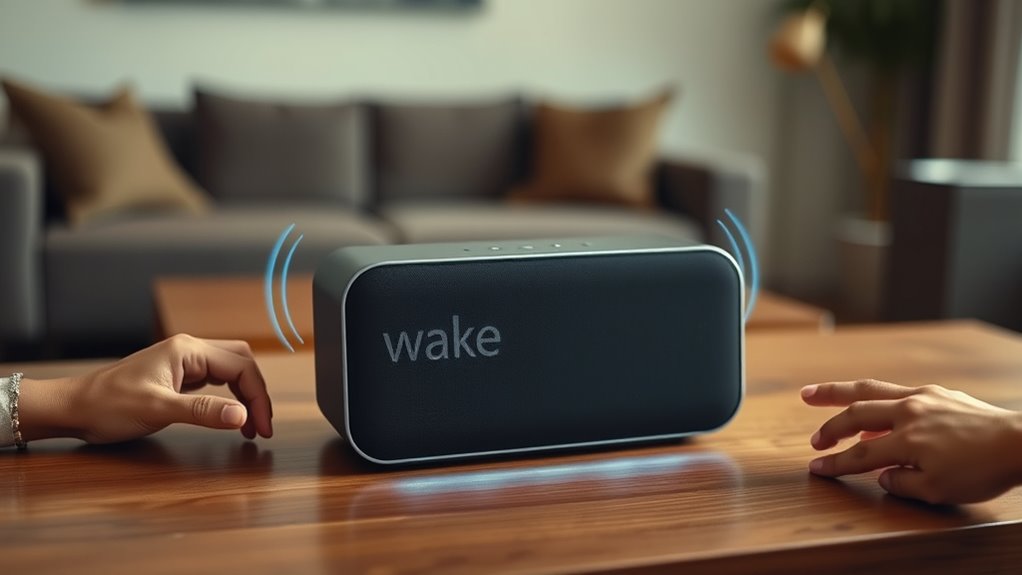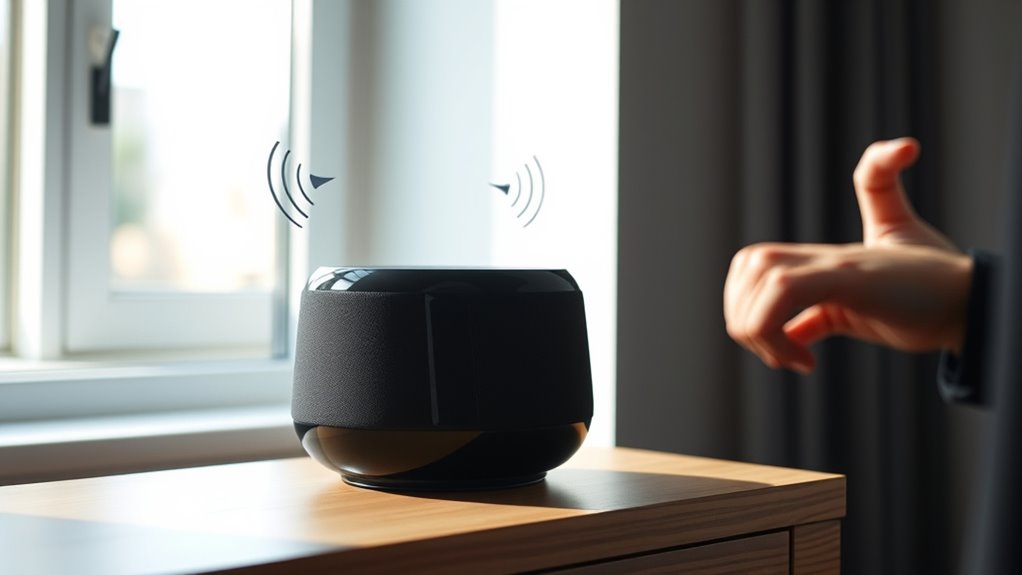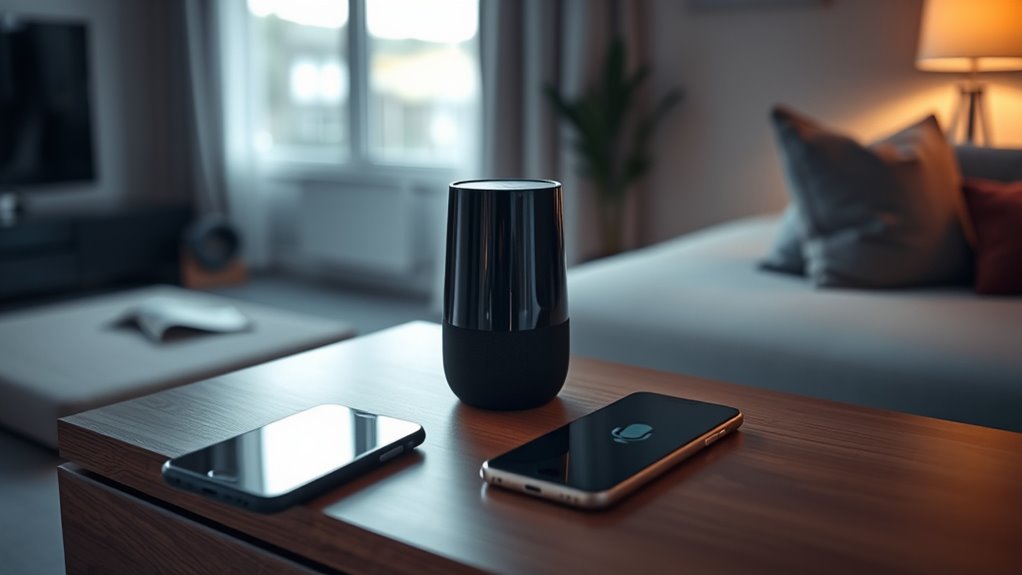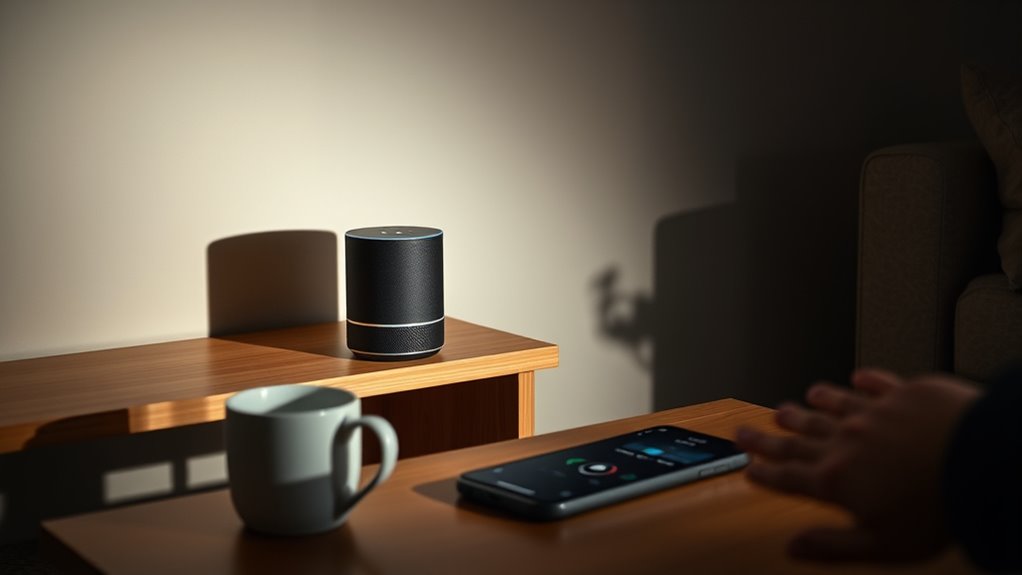Smart speakers constantly listen in the background but only record when they hear their wake words like “Hey Google” or “Alexa.” They analyze sounds passively until activated, but false triggers happen frequently—sometimes once an hour or more—due to background noise or similar phrases. These accidental recordings can pose privacy risks. To stay protected, you can manage settings or disable voice activation. If you want insights on keeping your data safe, there’s more to explore.
Key Takeaways
- Smart speakers constantly analyze sounds to detect wake words but only transmit voice data after activation, not continuously recording.
- False activations occur frequently due to background noise or similar phrases, risking unintended recordings.
- Accidental recordings can capture private conversations, raising privacy concerns about data storage and misuse.
- Managing privacy settings, deleting recordings, or turning off devices during sensitive topics helps control data collection.
- Connecting smart speakers to secure networks and being aware of data policies enhances privacy and reduces risks of unauthorized access.
How Smart Speakers Detect Wake Words

Smart speakers detect wake words like “Hey Google” or “Alexa” by constantly analyzing sounds through built-in microphones. These microphones stay active in standby mode, passively listening for specific wake words using advanced speech recognition algorithms. When you speak, the device processes the sound to identify the wake word, enabling wake word detection without transmitting voice data immediately to the cloud. This system helps prevent false activations, although similar-sounding phrases like “Okay, to go” can sometimes trigger the device. The accuracy of wake word detection varies among models, with newer versions typically offering better recognition and fewer false positives. By always listening in standby mode, your smart speaker remains ready to activate at any moment, but it does so without fully listening or transmitting your voice until the wake word is detected. Regular maintenance and understanding of air quality issues can help ensure your home environment remains healthy and safe. Additionally, the way these devices handle privacy concerns is an important aspect for users to consider. Advances in AI security research aim to improve the trustworthiness of these systems, balancing convenience with user safety.
The Reality of Continuous Listening and Activation

Although smart speakers are designed to listen continuously in standby mode, they don’t stay silent all the time. They constantly analyze background noise for wake words like “Hey Google” or “Alexa,” which triggers voice activation. However, false triggers happen frequently, sometimes caused by similar-sounding phrases or accidental recordings. Studies show devices can activate about 0.95 times per hour, with unintentional recordings occurring up to 19 times daily, often lasting only a few seconds. These accidental activations raise privacy concerns, despite privacy safeguards claimed by manufacturers. While smart devices aim to balance convenience and privacy, the reality is that always listening can lead to privacy breaches through false triggers and unintended recordings, making it essential to stay aware of how these devices operate in your home. Additionally, high sensitivity settings can increase the likelihood of unintended activation, further complicating privacy protection. Understanding how penetration testing is used to identify vulnerabilities in such devices can help consumers better grasp potential security risks. Recognizing that continuous listening involves ongoing background analysis highlights the importance of understanding device behavior and privacy implications. Moreover, the use of privacy controls and regular device audits can mitigate some of these risks by giving users more oversight over their recordings.
How Often Do False Recordings Happen?

False recordings happen more often than many users realize, with devices like Google Assistant and Amazon Alexa mistakenly activating roughly once an hour. These false activations are usually caused by voice recognition errors, where background noise or speech resembling wake words triggers unintended recordings. Even when the device isn’t meant to listen, background noise from TV shows or multilingual conversations can cause false activations. Studies indicate that Google Home Mini devices average about 0.95 unintended recordings per hour, highlighting how frequent false activation can be. While most smart speakers recognize the mistake quickly and stop recording, these false recordings still pose privacy risks. The error rate varies depending on the device and environment, making false activation a common aspect of modern voice-activated technology. Additionally, advancements in AI-powered voice recognition aim to reduce these false positives and improve overall privacy safeguards. Improving device sensitivity is a key focus in reducing unintended recordings and protecting user privacy, especially as AI developments continue to enhance detection accuracy. Efforts to refine privacy controls also help users manage when their devices are actively listening. Furthermore, ongoing research into noise filtering techniques seeks to minimize false triggers caused by ambient sounds, further protecting user privacy.
Causes Behind Unintentional Activations

Unintentional activations often stem from how smart speakers interpret sounds and speech patterns in their environment. False activations happen when the device misinterprets similar words or background noise as the wake word, leading to false triggers. For example, phrases like “okay to go” can activate your speaker because of imperfect wake word detection. Multilingual content or unfamiliar speech patterns, such as Spanish snippets from TV shows, increase the chance of accidental recordings. Device sensitivity also plays a role; higher sensitivity can cause more false triggers. Although newer Amazon Echo models show improved voice recognition, false activations still occur due to background noise or similar-sounding words. These factors combined make unintentional activations a common challenge in smart speaker technology.
Privacy Risks of Accidental Recordings

Smart speakers are always listening in standby mode, waiting for their wake words to activate. Unintended activations can lead to accidental recordings, raising privacy concerns. False triggers from similar phrases or sounds, like “okay to go,” increase the risk of accidental recordings. These recordings may capture sensitive information, including private conversations or personal data, without your knowledge. Once stored, your voice data becomes a privacy risk if mishandled or accessed without consent. Devices typically recognize accidental triggers quickly, but even brief recordings pose concerns. Here’s a breakdown of key concepts: voice data management. Additionally, the use of cookies can track user interactions with related devices and services, further impacting privacy.
Managing and Protecting Your Voice Data

How can you effectively safeguard your voice data from unwanted exposure? Start by managing your data through your smart speaker’s privacy settings. Regularly review and delete voice recordings to limit stored data. Use voice commands like “Hey Google, delete what I said this week” to automatically remove recent recordings. To prevent accidental recordings during private conversations, mute your microphone or turn off your smart speaker. Additionally, connect your device to a separate Wi-Fi network to isolate sensitive data. Always stay informed about your device’s privacy policy and review permissions to control what voice data your smart speaker accesses. By actively managing and protecting your voice data, you reduce the risk of unintended exposure and maintain greater control over your privacy.
Best Practices for Maintaining Privacy With Smart Devices

To maintain your privacy with smart devices, it’s important to adopt best practices that give you control over your data. Regularly review and delete your voice recordings through the device’s privacy settings to prevent unnecessary data collection. Use voice commands like “Hey Google, delete what I said this week” or “Alexa, delete my recordings” to quickly remove stored audio. When discussing sensitive topics, turn off your device or disable voice activation to avoid accidental recordings. Consider connecting your smart speaker to a dedicated Wi-Fi network to limit data sharing and enhance data security. Staying informed about your privacy options and adjusting settings regularly ensures your user privacy remains protected. These steps help you manage data collection and keep your smart devices from overstepping your privacy boundaries. Additionally, understanding the data collection practices of your device can help you make more informed decisions about its use. Being aware of the mind-body connection in somatic therapy underscores the importance of integrating physical sensations with psychological health, which can inform how you approach privacy and personal boundaries in digital spaces. Recognizing the brand reputation of your device can also influence your trust and comfort level with its data policies.
Frequently Asked Questions
Do Smart Speakers Listen to Your Conversations?
Smart speakers do listen to your conversations in a way that might surprise you. They’re always on standby, waiting for wake words like “Hey Google” or “Alexa.” When they hear those words, they activate and start recording. Sometimes, they mistakenly activate, capturing private moments without you realizing. Companies may also review some recordings to improve their AI, raising privacy concerns. So, yes, your smart speaker is always listening in standby mode.
What Are the Privacy Issues With Smart Speakers?
Like a silent sentinel, your smart speaker keeps watch, but it might eavesdrop without you noticing. Privacy issues arise because it can mistakenly record private moments, capturing sensitive details you never intended to share. Companies may listen to these recordings, risking confidentiality. To protect yourself, review and delete recordings regularly, turn off the device during private talks, and keep it away from sensitive areas, ensuring your secrets stay safe.
Are Your Smart Devices Listening to You?
Your smart device is likely listening to you constantly in standby mode, waiting for wake words like “Hey Google” or “Alexa.” It can accidentally activate due to background noise or similar sounds, recording conversations without your intent. You might not realize it, but recordings could be reviewed by companies to improve AI. Check your device settings regularly to manage or delete recordings and protect your privacy.
How Safe Are Smart Speakers?
Smart speakers are generally safe if you take proper precautions. You should mute them when not in use, regularly review and delete recordings, and tweak privacy settings to limit data collection. While they use encryption, vulnerabilities like hacking still exist. Be aware that accidental activations happen, and recordings may be stored without your consent. Staying cautious helps protect your privacy and ensures your smart speaker remains a helpful device rather than a privacy risk.
Conclusion
Now that you know how smart speakers listen, don’t leave your privacy to chance. Think of your device as a vigilant guard—always watching, sometimes overstepping. Take control by managing your voice data and setting boundaries. After all, isn’t it better to command your privacy rather than surrender it? Stay aware, stay cautious, and guarantee your smart speaker serves you—nothing more, nothing less. Your privacy depends on the choices you make today.









